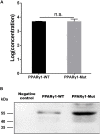An Upstream Open Reading Frame Represses Translation of Chicken PPARγ Transcript Variant 1
- PMID: 32184808
- PMCID: PMC7058706
- DOI: 10.3389/fgene.2020.00165
An Upstream Open Reading Frame Represses Translation of Chicken PPARγ Transcript Variant 1
Abstract
Peroxisome proliferator-activated receptor γ (PPARγ) is a master regulator of adipogenesis. The PPARγ gene produces various transcripts with different 5'-untranslated regions (5' UTRs) because of alternative promoter usage and splicing. The 5' UTR plays important roles in posttranscriptional gene regulation. However, to date, the regulatory role and underlying mechanism of 5' UTRs in the posttranscriptional regulation of PPARγ expression remain largely unclear. In this study, we investigated the effects of 5' UTRs on posttranscriptional regulation using reporter assays. Our results showed that the five PPARγ 5' UTRs exerted different effects on reporter gene activity. Bioinformatics analysis showed that chicken PPARγ transcript 1 (PPARγ1) possessed an upstream open reading frame (uORF) in its 5' UTR. Mutation analysis showed that a mutation in the uORF led to increased Renilla luciferase activity and PPARγ protein expression, but decreased Renilla luciferase and PPARγ1 mRNA expression. mRNA stability analysis using real-time RT-PCR showed that the uORF mutation did not interfere with mRNA stability, but promoter activity analysis of the cloned 5' UTR showed that the uORF mutation reduced promoter activity. Furthermore, in vitro transcription/translation assays demonstrated that the uORF mutation markedly increased the translation of PPARγ1 mRNA. Collectively, our results indicate that the uORF represses the translation of chicken PPARγ1 mRNA.
Keywords: 5′-untranslated region; PPARγ; gene expression; translational repression; upstream open reading frame.
Copyright © 2020 Chu, Huang, Ma, Cui, Yan, Li and Wang.
Figures








Similar articles
-
[Post-transcriptional regulation of chicken PPARγ transcript variant 3 by upstream open reading frame].Yi Chuan. 2018 Aug 16;40(8):657-667. doi: 10.16288/j.yczz.18-038. Yi Chuan. 2018. PMID: 30117421 Chinese.
-
Progranulin transcripts with short and long 5' untranslated regions (UTRs) are differentially expressed via posttranscriptional and translational repression.J Biol Chem. 2014 Sep 12;289(37):25879-89. doi: 10.1074/jbc.M114.560128. Epub 2014 Jul 23. J Biol Chem. 2014. PMID: 25056957 Free PMC article.
-
MicroRNA-27b contributes to lipopolysaccharide-mediated peroxisome proliferator-activated receptor gamma (PPARgamma) mRNA destabilization.J Biol Chem. 2010 Apr 16;285(16):11846-53. doi: 10.1074/jbc.M109.066399. Epub 2010 Feb 17. J Biol Chem. 2010. PMID: 20164187 Free PMC article.
-
DNA methylation promotes the expression of PPARγ transcript 1 at least in part by preventing NRF1 binding to the promoter P1 of chicken PPARγ gene.Poult Sci. 2024 May;103(5):103559. doi: 10.1016/j.psj.2024.103559. Epub 2024 Feb 16. Poult Sci. 2024. PMID: 38430780 Free PMC article.
-
Natural uORF variation in plants.Trends Plant Sci. 2024 Mar;29(3):290-302. doi: 10.1016/j.tplants.2023.07.005. Epub 2023 Aug 26. Trends Plant Sci. 2024. PMID: 37640640 Review.
References
LinkOut - more resources
Full Text Sources

